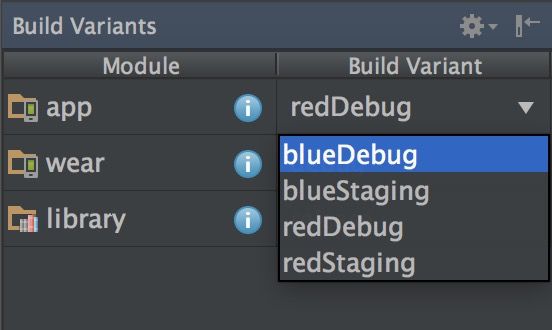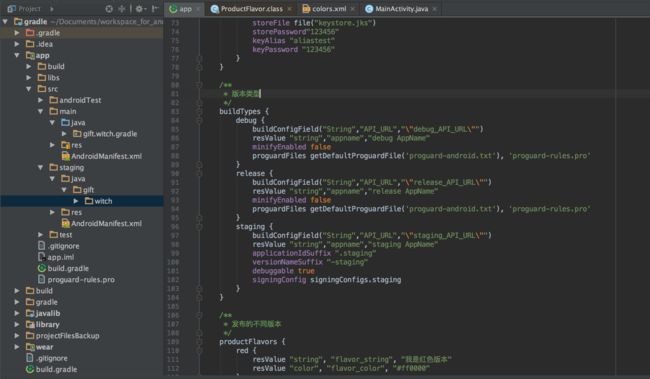Hi~我是Gradle
项目地址
https://github.com/iamludaxu/gradle
gradle项目结构
Gradle
├── build.gradle
├── settings.gradle
└── app
├── build.gradle
├── build
├── libs
└── src
└── main
├── java
│ └── gift.witch.gradle
└── res
├── drawable
├── layout
└── etc.
settings.gradle
include ':app', ':library', ':wear'
设置整个项目的结构,包括一个三个模块app、library、wear。
build.gradle
apply plugin: 'com.android.application'
android {
/**
* 编译的sdk版本
*/
compileSdkVersion 23
/**
* 编译的build-tools版本
*/
buildToolsVersion '25.0.1'
......
/**
* 资源映射
*/
sourceSets {
......
}
/**
* 默认配置
*/
defaultConfig {
applicationId "gift.witch.gradle"
......
}
/**
* 签名信息
*/
signingConfigs {
......
}
/**
* 版本类型
*/
buildTypes {
debug {
......
}
release {
......
}
}
/**
* 发布的不同版本
*/
productFlavors {
......
}
/**
* 依赖
*/
dependencies {
......
}
}
一、每个模块都会有一个build.gradle,根据模块类型不同会使用不同的插件
app模块
apply plugin: 'com.android.application'
library模块
apply plugin: 'com.android.library'
java模块
apply plugin: 'java'
二、defaultConfig默认配置
包含了该app的核心属性,该属性会重写在AndroidManifest.xml中的对应属性。
defaultConfig {
/**
* 应用ID
*/
applicationId "gift.witch.gradle"
/**
* 应用ID后缀
*/
applicationIdSuffix ".dev"
/**
* 最小sdk版本号
*/
minSdkVersion 14
/**
* 最大sdk版本号
*/
maxSdkVersion 23
/**
* 目标sdk版本号
*/
targetSdkVersion 23
/**
* 应用版本号
*/
versionCode 1
/**
* 应用版本名称
*/
versionName "1.0"
}
三、signingConfigs签名信息
定义签名信息,可以在defaultConfig,buildTypes和productFlavors中使用。
signingConfigs {
staging.initWith(signingConfigs.debug)
release {
storeFile file("keystore.jks")
storePassword"123456"
keyAlias "aliastest"
keyPassword "123456"
}
}
四、buildTypes版本类型
定义不同的版本,可以改变app中BuildConfig和resources的信息。
比如下面例子
- 通过buildConfigField方法增加BuildConfig中变量API_URL的值。
- 通过resValue方法增加string.xml中的appname的值。
- 通过minifyEnabled方法是否混淆
- 通过applicationIdSuffix方法增加appId的后缀
- 通过versionNameSuffix方法增加版本名称的后缀
- 通过signingConfig方法设置签名
- 在增加string的时候不能同时在string.xml中有相同的定义,否则会报错
buildTypes {
debug {
buildConfigField("String","API_URL","\"debug_API_URL\"")
resValue "string","appname","debug AppName"
minifyEnabled false
proguardFiles getDefaultProguardFile('proguard-android.txt'), 'proguard-rules.pro'
}
release {
buildConfigField("String","API_URL","\"release_API_URL\"")
resValue "string","appname","release AppName"
minifyEnabled false
proguardFiles getDefaultProguardFile('proguard-android.txt'), 'proguard-rules.pro'
}
staging {
buildConfigField("String","API_URL","\"staging_API_URL\"")
resValue "string","appname","staging AppName"
applicationIdSuffix ".staging"
versionNameSuffix "-staging"
debuggable true
signingConfig signingConfigs.staging
}
}
五、productFlavors发布的不同版本
- 通过resValue方法增加string和color
- 其拥有的方法和defaultConfig中相同可以修改app的核心属性
- 在增加string和color属性的时候,color.xml和string.xml不能出现相同的定义否则会报错
/**
* 发布的不同版本
*/
productFlavors {
red {
resValue "string", "flavor_string", "我是红色版本"
resValue "color", "flavor_color", "#ff0000"
}
blue {
resValue "string", "flavor_string", "我是蓝色版本"
resValue "color", "flavor_color", "#0000ff"
}
}
六、dependencies依赖管理
/**
* 依赖
*/
dependencies {
/**
* 本地依赖形式
*/
compile fileTree(include: ['*.jar'], dir: 'libs')
testCompile 'junit:junit:4.12'
/**
* 远程依赖简洁形式
*/
compile 'com.android.support:appcompat-v7:25.3.1'
/**
* 远程依赖完全形式
*/
compile group:"com.google.code.gson", name:"gson", version:"2.3"
testCompile "org.robolectric:robolectric:3.3.2"
/**
* 依赖项目
*/
compile project(':library')
stagingCompile 'junit:junit:4.12'
}
配置project.gradle
buildscript {
/**
* gradle使用的中央库
*/
repositories {
jcenter()
}
dependencies {
classpath 'com.android.tools.build:gradle:2.3.2'
// NOTE: Do not place your application dependencies here; they belong
// in the individual module build.gradle files
}
}
allprojects {
repositories {
jcenter()
}
}
预定义仓库
repositories {
mavenCentral()
jcenter()
mavenLocal()
}
增加远程仓库
maven { url "https://jitpack.io" }
增加私有仓库,需要用户名和密码
maven {
url "http://repo.acmecorp.com/maven2"
credentials {
username 'user'
password 'secretpassword'
}
}
本地依赖单个jar文件
dependencies {
compile files('libs/picasso-2.4.0.jar')
}
本地依赖多个jar文件
dependencies {
compile fileTree(dir: 'libs', include: ['*.jar'])
}
远程依赖两种形式
dependencies {
/**
* 远程依赖简洁形式
*/
compile 'com.android.support:appcompat-v7:25.3.1'
/**
* 远程依赖完全形式
*/
compile group:"com.google.code.gson", name:"gson", version:"2.3"
}
依赖library项目
dependencies {
/**
* 依赖项目
*/
compile project(':library')
}
构建变体
一、构建遵循如下规则
- Build types
- Product flavors
- Build variants
- Signing configurations
二、新增Source sets
创建了新的source set。默认情况下,该文件夹不会自动为你创建,所有你需要手工创建。比如增加了staging的文件夹。
三、新增依赖包
- 对于每一个BuildType,都可以在dependencies容器中添加名为BuildTypeNameCompile的依赖配置
- 对于每一个ProductFlavor,都可以在dependencies容器中添加名为ProductFlavorNameCompile的依赖配置
dependencies {
stagingCompile 'junit:junit:4.12'
redCompile 'junit:junit:4.12'
}
四、资源文件和manifest的合并
在打包app之前,Android插件会合并main中的代码和构建的代码。当然,依赖项目也可以提供额外的资源,它们也会被合并。你可能需要额外的Android权限针对debug变体。举个例子,你不想在main中申明这个权限,因为这可能导致一些问题,所以你可以添加一个额外的mainfest文件在debug的文件夹中,申明额外的权限。
资源和mainfests的优先级是这样的:
如果一个资源在main中和在flavor中定义了,那么那个在flavor中的资源有更高的优先级。这样那个在flavor文件夹中的资源将会被打包到apk。而在依赖项目申明的资源总是拥有最低优先级。
其他知识点
一、默认执行task
defaultTasks 'clean'
使用运行时./gradlew 就直接调用task clean
二、对apk进行重命名
/**
* 对输出的apk进行重命名
*/
android.applicationVariants.all { variant ->
variant.outputs.each { output ->
def file = output.outputFile
output.outputFile = new File(file.parent,file.name.replace(".apk","-${variant.versionName}.apk"))
}
}
三、过滤
/**
* 过滤
*/
android.variantFilter { variant ->
if(variant.buildType.name.equals('release')) {
variant.setIgnore(true);
variant.getFlavors().each() { flavor ->
if (flavor.name.equals('blue')) {
}
}
}
}
参考资料
Gradle for Android 系列
Gradle之构建变体(BuildVariant)
Android Plugin DSL Reference



